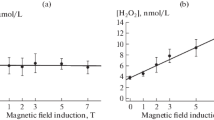Abstract
A study has been made of the influence of an electromagnetic field (EMGF) with a frequency in the 40–60 GHz range and intensity up to 4–8 mW on autowaves of concentration in the reaction of sodium bromate (0.3 M), malonic acid (0.2 M), sulfuric acid (0.45 M), and Ferroin (0.003 M). It has been found that the action of the EMGF leads to decreases in the wavelength by amounts up to 26%. The experimentally measured temperature gradient created by the EMGF in a thin layer of the reaction mixture is no greater than 0.4°K. The value calculated for the solution temperature rise that is required to create the experimentally observed decrease in wavelength is 5–6° K. It is concluded, therefore, that the observed effect cannot be explained solely by thermal action of the EMGF through heating the reaction mixture.
Similar content being viewed by others
Literature cited
A. M. Zhabotinskii, Concentration Autooscillations [in Russian], Nauka, Moscow (1974).
C. Walter, Enzyme Kinetics: Open and Closed Systems, Ronald Press, New York (1966).
A. T. Winfree, “Wavelike activity in biological and chemical media,” Lect. Notes Biomath., 2, 241–260 (1974).
I. Maselko, T. Tlaczala, M. Czerwinski, et al., “Oscillation reactions in the system: metabolites of Krebs cycle-manganese(2+)-potassium bromate-sulfuric acid,” Bioinorg. Chem., 2, No. 6, 529–536 (1978).
E. Koros, M. Burger, Z. Nagy, and M. Orban, “Oscillatory chemical reactions as models for studying bioprocesses,” Acta Pharm. Hung., 48, No. 4, 172–177 (1978).
T. R. Chay, “Oscillations in vesicular compartments,” Biophys. Chem., 13, No. 4, 325–328 (1981).
E. Sh. Ismailov, Biophysical Effect of Microwave Radiation [in Russian], Énergoatomizdat, Moscow (1987).
E. A. Andreev, M. U. Belyi, and S. P. Sit'ko, “Reaction of human organism to electromagnetic radiation in the millimeter range,” Vestn. Akad. Nauk Ukr. SSR, No. 1, 24–32 (1985).
A. S. Presman, Effects of Electromagnetic Fields on Living Organisms, Plenum Press, New York (1970).
L. P. Agulova, V. S. Kir'yanov, and A. M. Opalinskaya, “Change of fluctuation in Belousov-Zhabotinskii autooscillatory chemical reaction under the influence of a weak magnetic field,” Tomsk (1987); paper filed at VINITI, June 29, 1987, No. 3775-V87.
M. L. Smoes, “Chemical waves in the oscillatory Zhabotinskii system. A transition from temporal to spatialtemporal organization,” in: Dynamic Synergetic Systems, Proceedings of the International Symposium on Synergetics, Bielefeld (1979); published in Berlin (1980), pp. 80–96.
E. Koros, “Monomolecular treatment of chemical oscillation,” Nature, 251, No. 5477, 703–704 (1974).
M. J. Blandamer and D. L. Roberts, “Analysis of the dependence on temperature of the frequency of oscillation of the Belousov-Zhabotinskii reaction,” J. Chem. Soc., Faraday Trans. 1, 73, No. 7, 1056–1065 (1977).
L. Kuhnert, H.-J. Krug, and L. Pohlman, “Velocity of trigger waves and temperature dependence of autowave processes in the Belousov-Zhabotinskii reaction,” J. Phys. Chem., 89, No. 10, 2022–2026 (1985).
P. M. Wood and J. Ross, “A quantitative study of chemical waves and the Belousov-Zhabotinskii reaction,” J. Chem. Phys., 82, No. 4, 1924–1936 (1985).
A. S. Kovalenko, K. B. Yatsimirskii, L. N. Lugina, et al., “Influence of low-intensity electromagnetic radiation on concentration autowaves in Belousov-Zhabotinskii reaction,” Dokl. Akad. Nauk SSSR, 304, No. 5, 1143–1147 (1989).
Author information
Authors and Affiliations
Additional information
Translated from Teoreticheskaya i Éksperimental'naya Khimiya, Vol. 25, No. 6, pp. 704–709, November–December, 1989.
Rights and permissions
About this article
Cite this article
Kovalenko, A.S., Lugina, L.N., Andreev, E.A. et al. Influence of low-intensity electromagnetic field on autooscillations of concentration in belousov-zhabotinskii reaction. Theor Exp Chem 25, 647–652 (1989). https://doi.org/10.1007/BF00534446
Received:
Issue Date:
DOI: https://doi.org/10.1007/BF00534446




